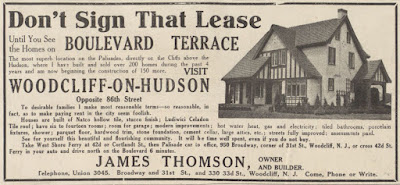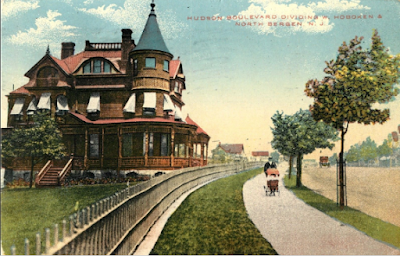"The Man Who Put Woodcliff on the Map"
It always feels like I mention James Thomson when talking about the building of North Bergen. Thomson was not a pioneer that bush whacked his way through Bergen Woods. He was not a wealthy resident that helped established New Durham either. In fact, Thomson only plays a small role in the history of the township, but has left an unrealized legacy that will outlast most other North Bergen notables. James Thomson was a builder and the most successful builder in North Bergen during the early part of the 20th century. He built more homes than the Woodcliff Land Improvement Company and holds greater responsibility for putting Woodcliff, and North Bergen, on the map more than any other person.
James Thompson, like many of the people who built North Bergen, was not native to North Bergen, but born in Scotland near the end of the 19th century. Thompson was quite the travel before becoming a real estate developer. He spent time in Australia, Africa and South America, he made his way around the world as crewman on cargo and passenger ships. In fact, when Thompson arrived in the United States in 1906 he had to borrow money from a shipmate to let him to land. Thomson worked in construction in New York City from the time he arrived until he made his way to North Bergen. Thomson had a background in construction as his father was home builder in his native Scotland.
In order for Thomson to be a success everything related to his venture not only need be perfect but he'd also need a little luck as well. Thomson accumulated some money after his arrival. He also spent his free time travelling around the suburbs of New York City area looking for an area to develop. He checked out 20 various locations before he decided on North Bergen, specifically the Woodcliff property. Thomson was willing to roll the dice on Woodcliff as he deemed it the best property for development at the time. He purchased his first Woodcliff lot in September of 1912 and sold it on November 20, 1912;
"33rd St, s side, 229ft w of Hudson Ave, 33.4 x 100"
The lot choice was a strategic one. Thomson was looking to make a name for himself, and this section of Woodcliff was the place to do it. During the early days of Woodcliff the only homes built were the Woodcliff Mansions. Only a handful are left today but Thomson was not in the business of mansion building, yet, he was in the business of direct to buyer construction. That first home was sold to Joseph Fyhr, a Swedish immigrant who worked as a machinist in a local factory. Thomson sold the lot back to Fyhr for $1 ($28.20 today), and mortgaged the home to him for $30 ($846.08) a month. However, as Thomson developed the area he did face competition. The Woodcliff Land Improvement Company owned almost all the property in what we know as Woodcliff today. William Haplin was an ambitious developer building the commercial and rental properties along Broadway. Then there were several other small builders all vying for space in the rapidly growing Woodcliff.
As stated before Thomson need everything to go right, and it was. He was successfully buying lots from the Woodcliff Land Company, building and selling quickly. But he need something else to happen. Something that would allow him to move past the Woodcliff Company. That something was the real estate slump of 1913 and 1914. While every other developer slowed down production, Thomson sped up construction. He purchased lot after lot and built homes all over Woodcliff. He was able to do this as Thomson acted as the owner of the Thomson Corporation, chief architect and shop keep. He oversaw every aspect of the business. He purchased the best materials from local outlets, building relationships to get material prices down, plus he always paid in cash. When credit was needed, he'd assume the entire line of credit, as well as offer full credit to buyers. Thomson was his own real estate agent, built directly to the buyer and was content with reasonable profit upon the sale of his homes. It was this that allowed him to overtake his competition and create the Woodcliff we know today.
The Boulevard Terrace District was designed to be a neighborhood of "popular priced dwellings and mansion types." The mansion style homes had a price $20,000 ($427,448.44), that was $15,000 above the average cost of a new home. The mansion would be constructed of Natco hollow tile and stucco. The roofs were Ludowici Celadon tile which were accented by copper gutters, leaders and hardwood trim. The homes also had something "new," thermometer clock regulation, the early 20th century version of a Nest. The mansions all came with a fireplace and laundry. Sun parlors or sleeping porches could be added if the buyer so wished. The mansions also came with the option for a 'servants' quarter with a separate entrance. The homes could have anywhere from eight to fourteen rooms, all with separeate bathrooms and ample closet space. Each building site had room for a garage, which many of the original owners opted for.
Today, the Boulevard Terrace District is home to an iconic North Bergen street, 75th Street's Red Brick Road. Ideally all the Boulevard Terrace streets were to laid with red brick. Sadly only 75th Street was laid out in such a grand fashion. The reason was a sharp increase in the price of building materials during the 1917 building season. Yet, that did not stop Thomson from building, in total, 70 homes in that neighborhood, including the James Braddock House.
James Thomson moved on from Woodcliff and North Bergen in 1918. He sold his family's grand home, 330 77th Street, and moved on to a venture in Somerset, New Jersey. He continued to build homes in the Somerset, Liberty Corner and Bernardsville area. The impact Thomson had on North Bergen in immeasurable. His homes have stood the test of time and are now worth a value of Mr. Thomson's wildest imagination. Thomson's dedication to construction and developing of Woodcliff are unbeknownst to the people who now call his homes...home. There is a charm when you walk the streets of Woodcliff and that charm is thanks to an ambitious builder named James Thomson. His homes will remain an unknown monument to the man who built Woodcliff.










Comments
Post a Comment